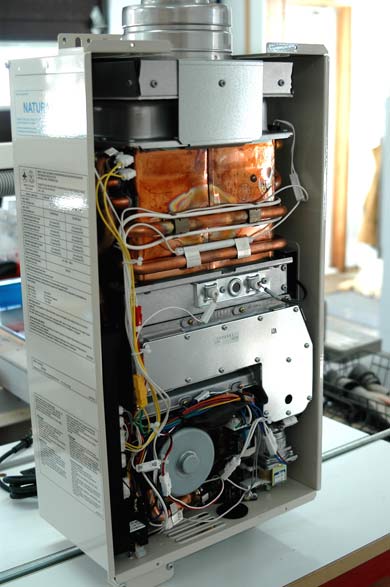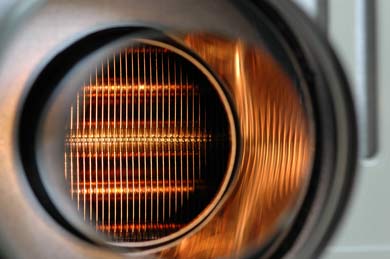Of all the ways energy is used in modern homes, heating water is one of the largest and arguably one of the most wasteful. About one third of all household energy consumption goes to heating water, and reducing this percentage is the driving force behind tankless water heaters.
Understand the Pros and Cons of Living with a Tankless Water Heater
 Also called on-demand water heaters, the roots of this technology go back to 1930s Europe. On-demand water heaters are not only much physically smaller than their tank-style counterparts, but also potentially more efficient. Today the technology is mature and reliable, though it’s not necessarily for everyone. You need to understand the pros and cons of actually living with an on-demand water heater before you can make an accurate decision about whether or not to invest in the technology.
Also called on-demand water heaters, the roots of this technology go back to 1930s Europe. On-demand water heaters are not only much physically smaller than their tank-style counterparts, but also potentially more efficient. Today the technology is mature and reliable, though it’s not necessarily for everyone. You need to understand the pros and cons of actually living with an on-demand water heater before you can make an accurate decision about whether or not to invest in the technology.
On-demand heating systems get their name from the fact that they heat water only as it’s needed. Without the energy required to keep a 40 or 60 gallon tank of water hot all the time, on-demand heaters do use less energy – all else being equal – because they eliminate stand-by cooling losses. The hitch, however, is the rapid rate of energy transfer required to heat two or four or six gallons of water each minute, from icy cold temps to steaming hot. In some situations this challenge is a non-issue, but in others it’s something that might cause problems you need to consider ahead of time.
There are Two Types of On-Demand Heaters:
- Electric
- Gas-fired (both propane and natural gas)
Gas is the way to go if it’s technically possible at your house. There are two reasons why and both spring from the high rate of energy transfer required to make on-demand water heating possible.
Electric On-Demand Heaters
Electric on-demand heaters offer the advantage of simplicity. They don’t need a chimney or wall vent, and they require no new gas pipe connections entering your home. simple wiring and plumbing connections are all that’s needed. The challenge, however, is the high rate at which on-demand heaters use electricity when water is flowing, and the wiring and electrical infrastructure required to support this current draw.
The fact is, it’s not unheard of even for homes with a 200 amp electrical service to lack sufficient capacity to support an electric on-demand heater along with other domestic loads. Before you make a purchase, contact an electrician to determine if your home has what it takes to support electric on-demand technology. Also, as electric utility companies start to change to smart metering systems, it’s quite likely you’ll be financially rewarded for keeping your peak electrical usage low and centered during off-peak hours. The sharp spikes in electricity usage created by non-gas on-demand water heaters makes life more difficult for utilities and will probably be financially discouraged more and more as time goes on.
Gas-fired On-Demand Heaters
Gas is a better energy source when dealing with high rates of energy consumption, and this is why gas-fired on-demand heaters are the dominant technology. Models that vent through the wall are typically easier to install because they need no chimney, though these direct vent models are sometimes more technically complicated and expensive.
Do You Have an Accurate Sense of How Much Hot Water You Consume?
Regardless of the type of on-demand heater you choose, it’s important to get an accurate sense of how much hot water you’re likely to need at any one time. Any model you choose must be able to match your gallons per minute water demand. Some units, for example, can only heat enough water for one shower at a time. If someone decides to do the dishes while you’re lathering up, you both get lukewarm water. Models are certainly available large enough to handle multiple loads, you just need to realize that it’s important to look for them specifically. This is especially true if your incoming water is particularly cold, as you’d get from a deep well.
 Also, if your water supply is rich in dissolved minerals, you may have to periodically remove scale build up on the heat exchanger inside the unit. Be sure that water supply lines feeding the heater are equipped with shut off valves and quick disconnect fittings to make this maintenance chore easier.
Also, if your water supply is rich in dissolved minerals, you may have to periodically remove scale build up on the heat exchanger inside the unit. Be sure that water supply lines feeding the heater are equipped with shut off valves and quick disconnect fittings to make this maintenance chore easier.
On-demand water heaters are here to stay, and that’s a good thing. They’re a compact, efficient, reliable option for many Canadian households. Understand what’s involved in choosing well for your situation and you’ll be heating water as efficiently – and enjoyably – as possible.